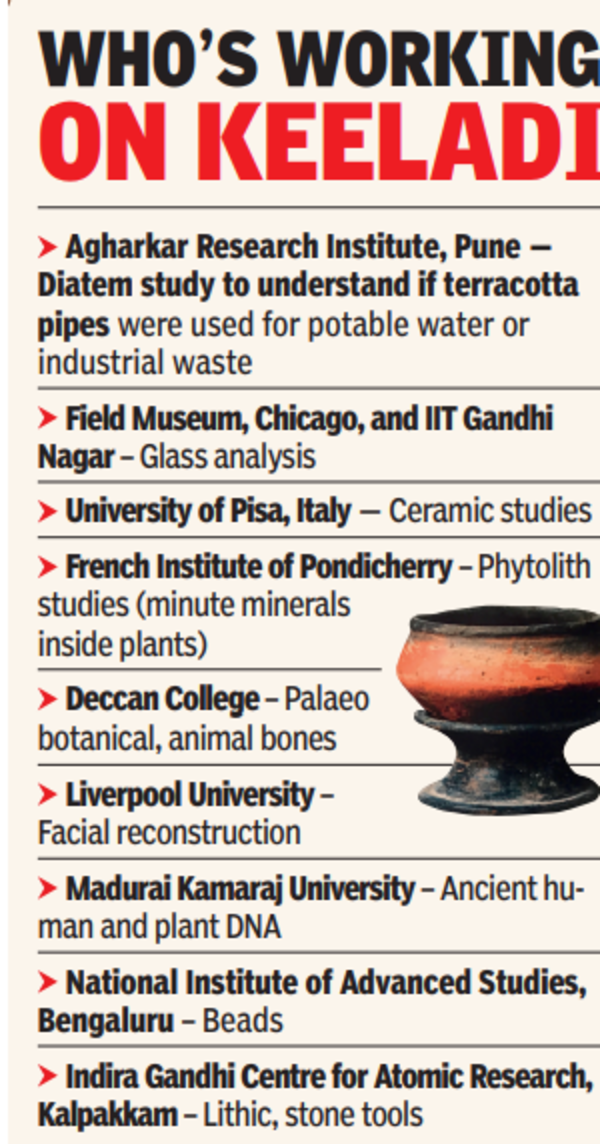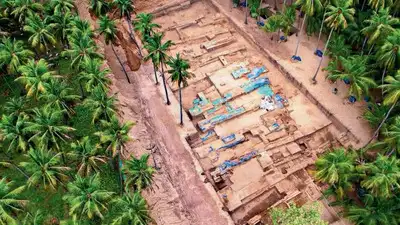India’s second urbanisation: It’s confirmed, Keeladi is as old as the Gangetic plains; radiocarbon dating traces site’s origins to 580BCE | Chennai News – Times of India

The Keeladi site in Madurai has revealed yet another chapter in Tamil Nadu’s past. Radiocarbon dating by US laboratory Beta Analytics has confirmed that it dates to 6th century BCE, making it contemporary with the urbanisation of the Gangetic plains.Of the 29 radiocarbon samples dated by the Tamil Nadu state department of archaeology since the 2017-18 excavation season, the earliest was from 580BCE and the most recent from 200CE.The findings point to an urban and industrial settlement that flourished for 800 years between 6th century BCE and 2nd century CE. The large brick structures from the Sangam Age found here are evidence of the urbanisation described in Sangam literature.“Most samples above the brick structures date to after the 3rd century BCE, while those below go as far back as the 6th century BCE,” says archaeologist K Rajan, advisor to Tamil Nadu’s archaeology department. “This places Keeladi alongside the urbanisation of the Gangetic plains, India’s second urbanisation. Of the 29 radiocarbon dates, 12 fall in the pre-Ashokan era, before the 3rd century BCE.”

It also looks like the archaeologists are inching closer to revealing the face of the ancient Tamil, who lived in the Keeladi settlement thousands of years ago, using 3D technology and anthropometric measurements from a skull unearthed at the Kondagai burial site.“Based on the skull, we will reconstruct the age, dietary pattern, determine the gender, and actual face of the person,” says Rajan.The state archaeology department is collaborating with more than 20 research institutions from India and overseas on the project, including Liverpool University in the UK, University of Pisa in Italy, the Field Museum in Chicago, the French Institute of Pondicherry, IIT Gandhinagar, and Deccan College, to reconstruct life in Keeladi in 580 BCE.The Deccan College is analysing animal bones found in Keeladi. Excavations uncovered bones of bulls, buffaloes, goats, cows, sheep, dogs, pigs, antelope and spotted deer. Madurai Kamaraj University researchers are working on analysing ancient human DNA and animal DNA, which will help understand human migration and admixture of the ancient inhabitants of Keeladi and Kondagai, a cluster village of Keeladi.

This scientific approach has yielded 29 dates from a single site.The Tamil-Brahmi inscribed potsherds unearthed at Keeladi have pushed the script’s origin back to the 6th century BCE. Gold and ivory artefacts suggest the ancient Tamils led a life of luxury.“It shows Keeladi was an urban settlement with a literate society and a community of artisans,” says R Sivanandam, joint director, state archaeology department. “It was an industrial hub along an ancient trade route linking the east coast port of Alagankulam to Muziris on the west coast via Madurai.” The original name of the settlement, however, remains unknown.Sangam literature talks about overseas trade, ornaments, gemstones, cities and streets and palatial buildings. “Keeladi has proved that Sangam literature was a lived experience of ancient Tamils and not imaginative stories,” says indologist R Balakrishnan.Archaeologists also found terracotta and ivory dice in rectangular and cubic forms at the site, which Balakrishnan says is mentioned in ‘Kalithogai’, sixth of the eight anthologies of Sangam literature.“Keeladi isn’t the only site with roots in the 6th century BCE. Kodumanal, Porunthal, Sivagalai, Adichanallur and Korkai have also yielded dates from that period,” says Rajan. “Korkai has produced a date as early as 785BCE, suggesting Sangam-age urbanisation was widespread.”Despite 10 seasons of excavations at Keeladi, researchers have excavated only 4% of the 110 acres of cultural deposit in Keeladi. The state govt plans to continue excavations and has set up a museum to showcase the findings, with an onsite museum, the first of its kind in India, also in the works. “Tamil Nadu has endured archaeological apathy for far too long until Keeladi sparked a wave of interest among Tamils,” says Balakrishnan. “Keeladi is the first site that transformed the understanding of archaeology in Tamil Nadu,” says Rajan.KEELADI CONTROVERSYArchaeologist K Amarnath Ramakrishna, who led the first two excavation seasons (2014-2016), submitted a report in 2023 to ASI stating that Keeladi functioned between 8th century BCE and 3rd century CE. Two years later, ASI challenged the dating, claiming the site could best be dated to 300 BCE and asked Ramakrishna to revise his report. Ramakrishna defended his original findings. Two days ago, Union minister for culture and tourism Gajendran Singh Shekhawat also stated that the report was not technically well supported and further scientific validation is neededWHY IS KEELADI IMPORTANT?Contains brick structural remains from the Sangam Age (early historic period)Among the few sites in Tamil Nadu, along with Arikamedu, Kaveripattinam and Korkai, to yield a wide variety of structures such as complex brick structures, drainage systems with tank-like features, doublewalled furnaces, terracotta ring wellsHOW RADIOCARBON DATING WORKSLiving organisms absorb carbon, including the radioactive isotope C-14, from the atmosphere. When they die, C-14 intake stops and the organism begins to decay at a known rate. Measuring the remaining C-14 helps estimate the time of death of the organism. A common technique used is accelerator mass spectrometry, which directly counts C-14 atoms, requires just 1g of sample and has dating accuracy within ±30 yearsKEELADI FINDSExcavated area is 90m long and 60m wide. Artefacts include glass, shell, ivory, pearl and terracotta beads; seals; dice, unidentified copper coins; gold ornaments
















